After cutting the grass and raking the leaves at almost every one of the neighbors’ homes surrounding my Mom and Dad’s house, I had finally saved the requisite sum of money to purchase my first audiophile stereo system. My Mom, ever the kind soul, took me to the stereo store to purchase my beloved system. As I was only 15 at the time, I could not yet drive. I was filled with anticipatory excitement as I set up my newly-obtained treasure on the floor. A week or so later I graduated to my first official audio rack – two heavy-walled cardboard boxes that the manager of the local grocery store gave me. I also seem to remember my Dad cutting a piece of wood to place on the boxes for better support. And my journey into the world of where to house an audio system began.
In modern times, audio racks are often completely overlooked. In more than a few cases, a dedicated rack is not even used, the preferred system placement being behind the closed doors of a cabinet or wall unit. Future Audiophile thought it might be interesting to take a look at audio racks and examine if there are any real benefits in using a dedicated rack system, or if hiding a stereo away in a cabinet might be the better way to go.
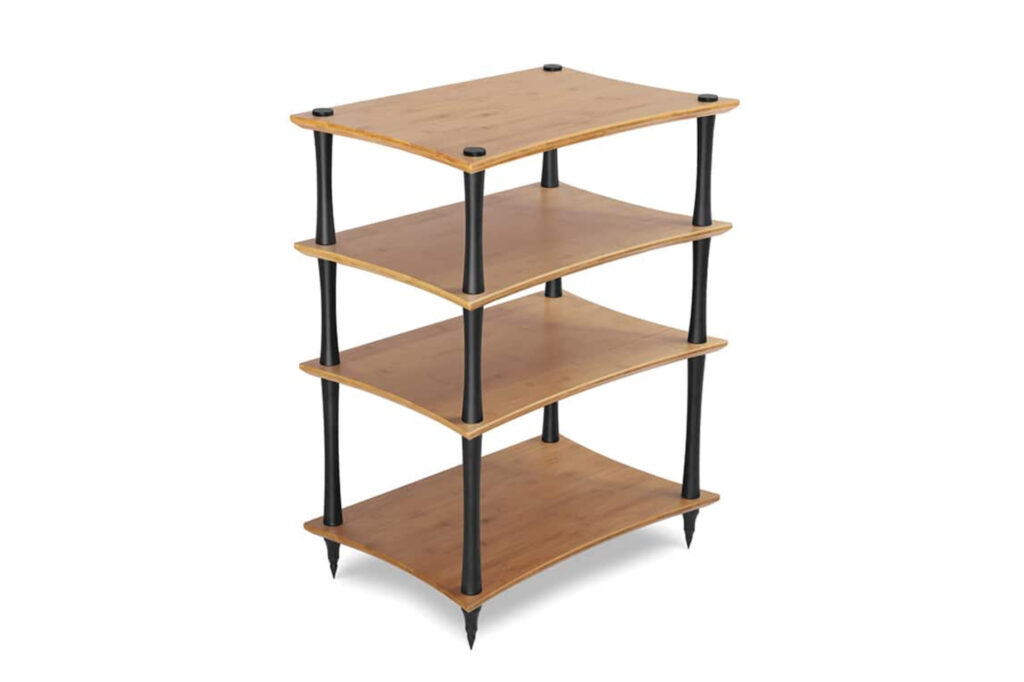
What is the Main Function of an Audiophile Equipment Rack?
I see the audiophile hobby as predominantly sonically driven. We want, first and foremost, our systems to sound magnificent. We want to obtain the illusion of a natural-sounding musical event in our listening space. However, visual acuity is also important. Spend five figures (or more) on a power amp or, realistically, any audio component, and an attractive appearance is also highly desired. In fact, a stunning appearance is very often an important trait for our beloved systems. Take a dedicated audio room, incorporate some appropriate mood lighting, place a nice-looking audiophile system on an equally gorgeous rack, and it can be an impressively stunning sight to behold. When visitors first enter the audio room, it can very often create an oh-wow moment.
But the main function of a rack is far more important than its visual statement. Its main purpose is to help foster aural excellence. While an attractive appearance is certainly important, sounding spectacular is the real star of the show. Seeing a system sitting on a rack in a gorgeous room commands only a minute or two of our attention. What we hear can go on for hours, days, as long as we own our system. So, the primary function of an audiophile rack is to help elevate sonic performance.

Vibrations Are Not an Audiophile’s Friend
The predominate function of an audiophile rack is to isolate the equipment from vibrations. All audio components vibrate: amps, preamps, CD players, DACs. If you have a turntable, you have an even greater potential for vibratory degradation of the audio signal.
Almost every part inside our audio components produces unwanted vibrations. Power supplies, transformers and capacitors are especially notorious culprits. However, circuit boards are also a contributor. When these and anything else inside those beautifully sculpted cabinets vibrate, the result will often be what is called “microphony.” The microphonic effect occurring in any one component occurs because vibrational energy, or the vibrations occurring inside the housing, is converted to electrical energy and is passed along as, you guessed it, distortion. Tubed components may be especially susceptible to this condition. In fact, for some tubed equipment, lightly tapping on the housing may cause the tapping sound to be heard through the speakers. This is a prime example of the conversion of mechanical energy to electrical energy. If you really want to have some fun, try shouting into one of those large, glorious tubes on top of an amp and see if you hear your voice through the speakers. You might be very surprised. While not a total remedy, equipment racks, depending on the design, may help eliminate most of the mechanical energy and prevent it from being converted to electrical energy, which would otherwise ultimately manifest as distortion.
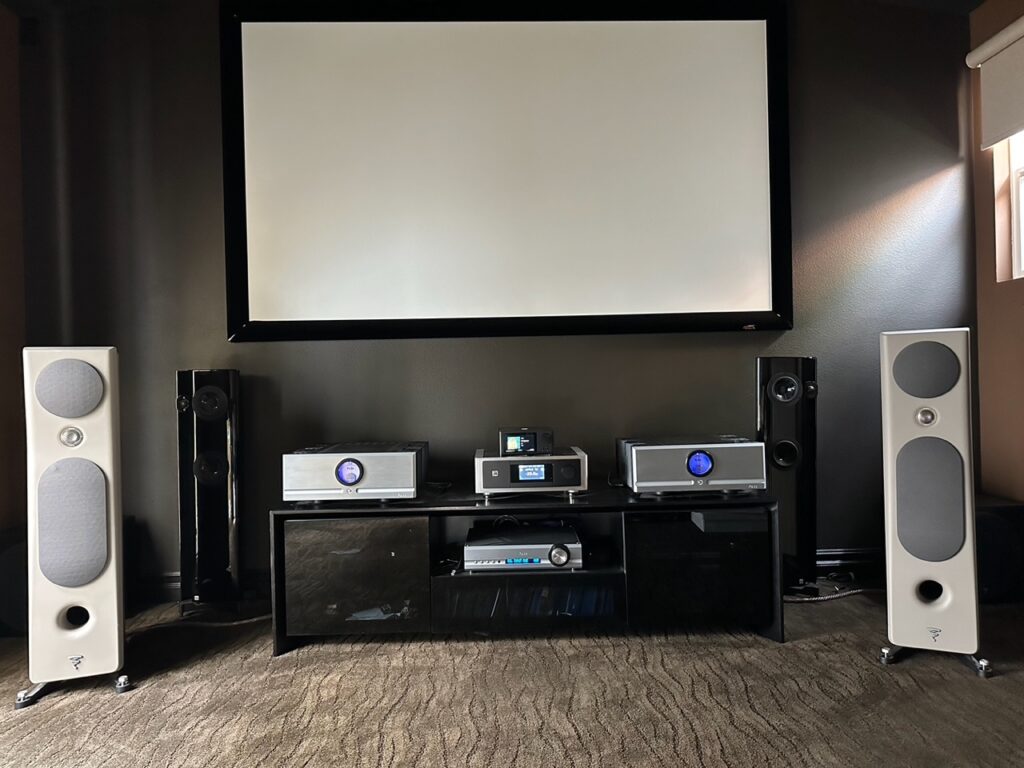
Turntables Are Especially Vulnerable to Sound-Altering Vibrations
Because the primary job of a phono cartridge is to pick up the tiny vibrations of the needle weaving its way through the grooves cut into a spinning LP, cartridges by their very nature are experts at picking up unwanted sounds. Place a turntable close to anything with a large transformer or a power supply, and an effect called a ground loop hum may be the result. These odious sounds are irritating and, very likely, particularly difficult to pin down when it comes to their cause. While a rack with vibration absorption properties may not completely remedy this problem, it usually is a good start. And, for lovers of vinyl LPs, it is always best to put a turntable well away from anything with a large transformer or power supply. Doing so helps eliminate the possibility of the ensuing vibrations being picked up by an overachieving cartridge.
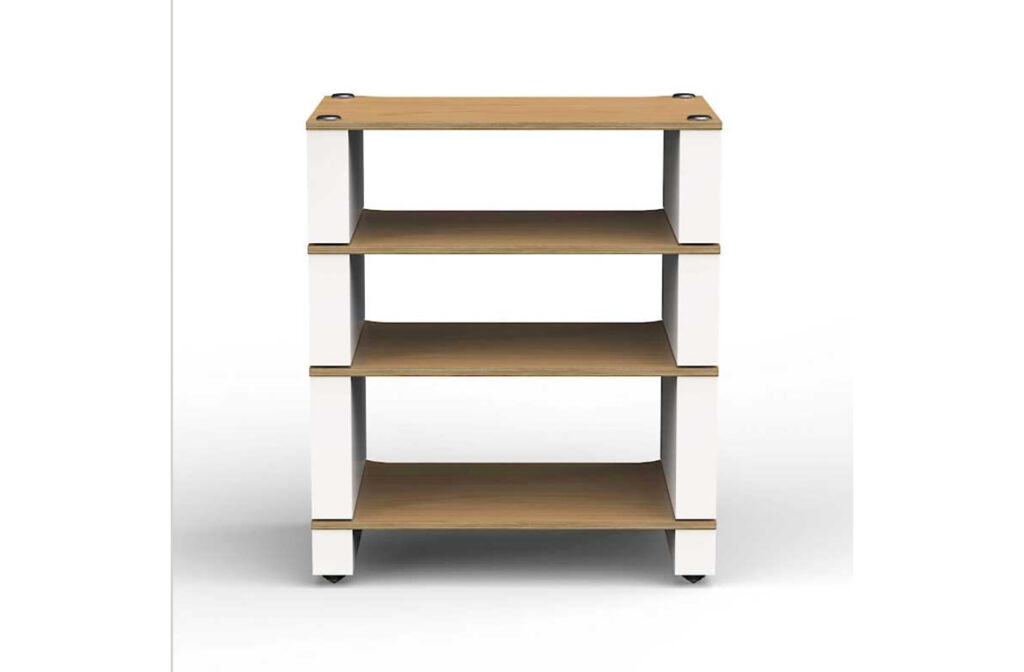
How Does an Audiophile Equipment Rack Help Sonically?
- First and foremost, any audiophile equipment rack with significant mass is always desirable. Mass and an inert structure will help alleviate what are typically termed as sympathetic vibrations. This is a condition when one object begins to vibrate, normally at the same frequency, in response to another object. The vibrations of one component are, in this case, transferred to a secondary object. A tube amp picking up the vibrations of a closely-placed set of large floorstanding speakers are one such example. An equipment rack with sufficient mass is less likely to promote this sympathetic vibration effect, thus not degrading the sound.
- Another positive effect of an equipment rack is vibration absorption. Many of the better equipment racks utilize specially designed shelves and platforms to draw vibrations from the cabinet before it even has the chance to be converted to electrical energy. It is quite common for these shelves to use constrained layer dampening to facilitate vibratory reduction. Most often, a layer of a vibration-absorbing material will be sandwiched between two (or sometimes more) layers of another material. When the vibratory energy passes into the constrained dampening layer, the energy is subsequently converted to a fractional amount of heat and harmlessly dissipated. The vibrations are therefore removed.
- Lastly, there is component isolation. It is always best when any two components are not placed in close proximity to each other. This is a great first step in eliminating sympathetic vibrations and ensuring that the vibrations of one component do not affect another one. A rack large enough for some distance between components is always advised. It is never recommended to place one component directly on top of another one. Be sure your equipment rack is large enough to hold every component in your system all by itself and on one level.
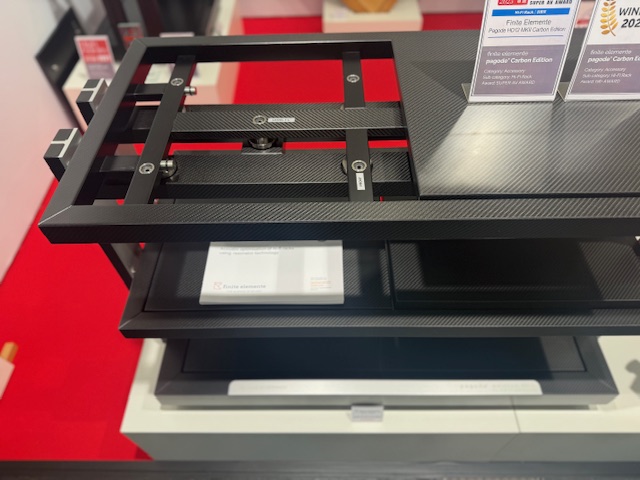
What Are Some Important Features of Audiophile Equipment Racks?
- As previously mentioned, look for a rack that has sufficient mass and is not flimsy. A high level of rigidity is always a desirable feature. It is also highly recommended to avoid the ubiquitous “stereo stand” sold generically in mass-market furniture stores. These racks offer almost zero protection against vibrations.
- It is also advisable to look for a rack made from rigid material. Carbon steel, stainless steel and heavy-walled aluminum are all wise choices. Some enthusiasts also like to fill the legs with sand to increase mass and likewise the vibration-absorbing capabilities. Sand is also quite inexpensive and may offer a cost reduction when compared to a very heavy, high-mass audio rack. Wood may also be used, as long as the type of wood is sufficiently dense and heavy.
- A very popular feature is the ability to adjust the height of the individual shelves. If you have a 10-inch-tall integrated amp, for instance, and your newly-purchased amp is 16 inches tall, you will very likely need to increase the height of the shelf. Being able to vary these dimensions is a valued asset.
- Look for racks with vibration-absorbing shelving. As mentioned above, a shelf with constrained layer dampening is a great path to the reduction, and optimally elimination, of vibrations from individual components.
- An open-air construction is highly recommended. Audio gear can very often get hot, especially tubed components. So, airflow is a must. It is also highly valuable to have some sort of cable management system, although this feature is rare for most racks.
- Many audiophiles prefer their racks to have downward spiked feet to anchor the legs to the floor. These spikes actually tend to act as a diode and only allow vibrations to flow in one direction. Spikes are typically sharp enough to pass through carpet and imbed themselves in the plywood beneath. This provides a path of harmless dissipation of the vibrations removed from the components on the rack. If spikes are used on a hardwood floor, be sure to use a small, flat, piece of metal where the spike can sit. Many of these parts have felt on the bottom to keep from scratching a wooden floor.
- Visual beauty is also very likely a must-have. All audiophiles want their system to be a thing of beauty. In my research for this article, I found some very modern-looking audio racks. Some were even decidedly avant-garde. Stylistically, there are enough rack designs to accommodate almost any taste.

How Much Should a Decent Audio Rack Cost?
Wow, what a difficult question to answer. First and foremost, it depends on the size of the audio system itself. Someone with an integrated amp, a music server, CD player or streaming device and little else will need a far smaller rack than someone with multiple enclosures. However, if, like me, you have all separate components and several with their own separate power supply, a rack with much more space will be necessary. Turntables offer their own challenges. On my rack, the turntable sits all alone on top of a piece of granite that is three-quarter-inch-thick, 22 inches deep and 64 inches long.
It therefore goes without saying that the size and the overall mass of the rack are significantly determining factors in cost. A two-section-wide rack, three shelves tall, such as those from Monoprice, sell for just under $350. It does not have features such as shelving with any dampening properties. It is somewhat modular and the height of the mostly sturdy shelves is adjustable. A similar rack from, say, Critical Mass Systems, HRS or Stillpoints – one with all the bells and whistles – may cost $20,000 or more. I once priced the Critical Mass Olympus-Ultra series of racks, and one large enough for my system was about $50,000. While a definitive pricing range is difficult, due to the wide variety of system choices, a good rack with some of the properties illustrated in this article should cost somewhere in the $5,000 range. There are any number of popular racks for $1,500 to $3,000. However, their performance capabilities will also vary.
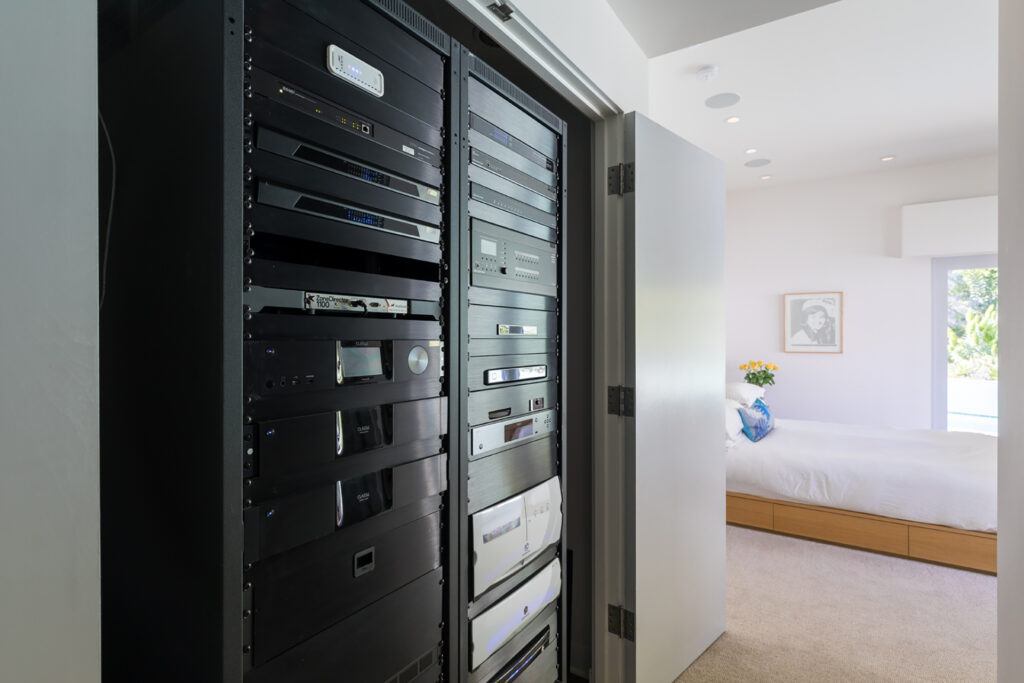
Final Thoughts on Audiophile Racks Equipment Racks …
What for me began as a couple of cardboard boxes has progressed through a series of storage solutions. I once had an integrated amp and Compact Disc player in a large cabinet that also housed my TV. I could close the doors of the cabinet and hide everything. Today, I have a custom rack made from Brazilian hardwoods, MDF shelving bases, Sorbothane insulation and three-quarter-inch-thick granite. Long way from a cardboard box, but not really what I would like. I would really appreciate some adjustability in shelving height, something mine does not have. Visually, however, it is quite impressive and fits with my overall décor. Sonically, it does get the job done. It is very massive, weighing in with no gear at about 600 pounds.
In modern times, racks for an audiophile system can be designed with the same engineering disciplines as those of many aerospace components. They can combine some measure of performance and cost, or may be prohibitively expensive with world-class sonic enhancements.
Today, audio racks are considered by many to be as important as the components themselves. Many audiophiles would not consider placing their system in a cabinet, closing the doors and hiding it from ever being seen. Because of the cost of most audiophile systems, we want them to be viewed for the stunning masterpieces they are. And if we can find some measure of enhanced sonic performance along the way, considering a rack as part of the whole system makes sense. Whether you spend a little or a lot, it is certainly advisable to consider the contributions a well-designed audio rack may make. They can be champions both sonically and visually. And best of all, they are better than a cardboard box.
How do you rack and stack your audiophile gear? Some use IKEA furniture. Others, like our publisher who dabbles in custom installation and smart home gear, use Middle Atlantic Racks. Monoprice makes pretty affordable racks that are quite good. HRS makes audiophile equipment racks that cost enough to put your kid through a year at Princeton. Tell us about how you house your audiophile system. We love to hear from you and will moderate your comments quickly.




The best thing I believe is not pile up a bunch of components between your speakers.
My equipment was on a home made timber shelf. Then I bought a $50,000 eight level YG rack. It sounds no different.